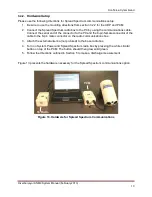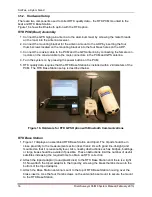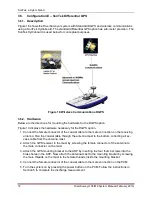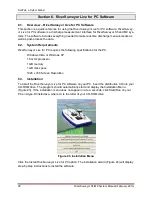
SonTek, a Xylem brand
RiverSurveyor S5/M9 System Manual (February 2013)
27
Velocity Profile Extrapolation uses a power law velocity profile proposed by Chen (1991), and
Simpson and Oltmann (1990), to calculate velocities above and below the Measured Area.
Where u is the velocity at height z measured from the river bottom, u* is the bottom shear veloc-
ity, z0 is the bottom roughness height, and b is a constant (equal to 1/6 according to Chen,
1991). Use of this equation assumes the currents in the profile are traveling in approximately the
same direction. In situations where this may not be the case, (e.g., Stratified Flows or bi-
directional flow), one of the other extrapolation methods, available in the
RiverSurveyorLive
software, should be used. By default, the
RiverSurveyorLive
software uses the 1/6th Power Law
velocity profile (described above) using the entire measured velocity profile to calculate veloci-
ties in the top and bottom unmeasured areas.
The velocities are now known for each of the estimated top and bottom areas. The discharges
for each component are calculated based on the velocities, depth and movement of the vessel
across the transect.
The discharge in the Start and End Edges is calculated from a mean velocity profile that is de-
veloped by maintaining a (relatively) fixed position at the edge. It is important that the vessel be
kept as stationary as possible at the edge. The velocity profiles measured at this time will be
combined together to produce a single average profile. The discharge calculation at the edge is
based on the selection of a constant sloped bank or vertical wall and uses a combination of the
mean depth and velocity profile at the edge.
In the Transect, the discharge calculation is based on the depth, distance travelled and the
mean water velocity. During this time the system automatically compensates for changes in the
vessel course and speed.
One of the key benefits is that the PC and mobile software step through this entire process and
do the calculation of discharge automatically.
5.3.8.
Starting The System
After the system is configured, start the system collecting data.
5.3.9.
Collecting Start Edge Data
Position the vessel for the starting edge position and begin collecting edge data with the vessel
as stationary as possible. It is recommended that a minimum of 10 profiles/samples are collect-
ed to perform the edge discharge calculation. Enter the edge distance and shape.
5.3.10.
Collecting Transect Data
After collecting the start edge data, proceed to move the vessel across the channel. Keep the
vessel speed and direction as constant as possible.
5.3.11.
Collecting End Edge Data
After moving across the channel and arriving at an end edge location, enter the end edge dis-
tance and shape. Collect at least 10 samples/profiles with the vessel as stationary as possible.
5.3.12.
Making Additional Measurements/Transects
After entering the end edge information, the measurement is complete. Another measurement
can be started from the same location or the system can be shut down.
Содержание SonTek River Surveyor M9
Страница 10: ......
Страница 118: ......
Страница 150: ...SonTek a Xylem brand 140 RiverSurveyor S5 M9 System Manual February 2013 Figure 126 Island Edge...
















































